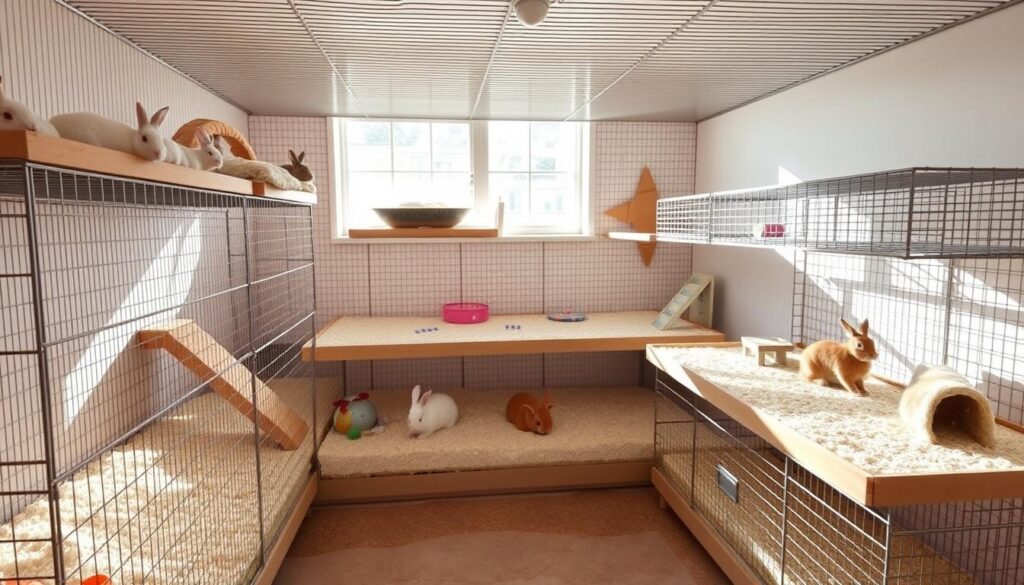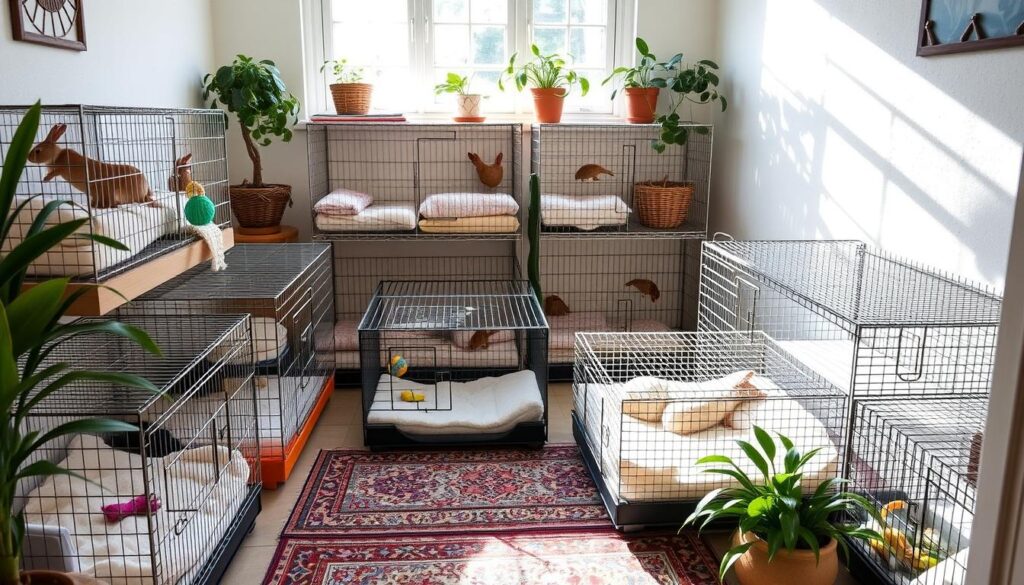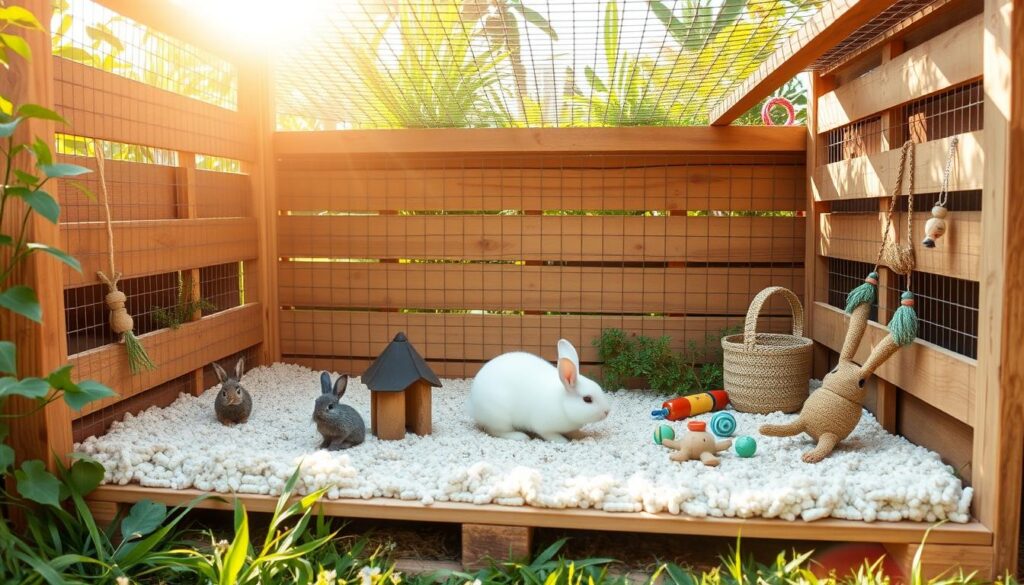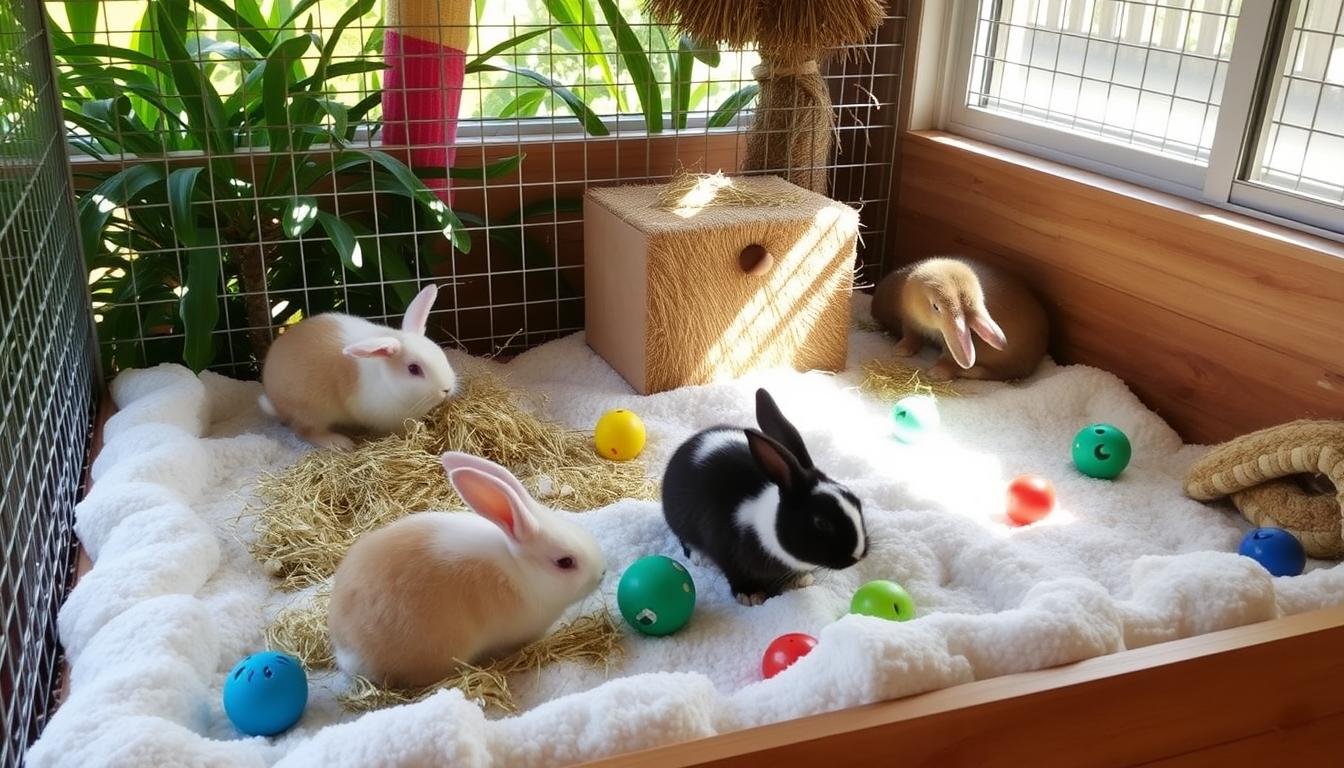It’s vital to give your rabbit a safe and comfy home. The right cage can make a big difference. It should be well-ventilated, spacious, and easy to clean. There are many options, like indoor cages and outdoor hutches, to choose from.
Getting a top-notch rabbit cage is a smart move. With so many choices, think about space, air flow, and how easy it is to clean. The right cage will keep your pet happy and healthy.
Key Takeaways
- Providing a comfortable and safe home for your rabbit is crucial for its health and happiness.
- Choosing the right rabbit cage can make a significant difference in your pet’s life.
- Rabbit cages should be well-ventilated, spacious, and easy to clean.
- Indoor rabbit cages and outdoor rabbit hutches are available options.
- Investing in one of the best rabbit cages can ensure your pet’s overall well-being.
- Considering factors such as space, ventilation, and ease of cleaning is essential when selecting a rabbit cage.
- Rabbit cages play a vital role in creating a happy and healthy environment for your pet.
Understanding Your Rabbit’s Housing Needs
Providing a comfy and healthy home for your rabbit is key. They need lots of space to roam. Indoor rabbit cages are a good choice, offering a safe spot for your pet.
Rabbits don’t like extreme temperatures and need air to breathe well. So, picking a cage with good temperature and ventilation is vital. A cage with good air flow helps prevent breathing issues and keeps your rabbit cozy.
Space Requirements for Different Rabbit Breeds
Different rabbit breeds need different amounts of space. Big rabbits, like Flemish Giants, need more room. Smaller rabbits, like Netherland Dwarfs, need less. Here’s a rough guide:
- Small breeds: 2×4 feet of floor space
- Medium breeds: 2×6 feet of floor space
- Large breeds: 2×8 feet of floor space
Essential Housing Features for Rabbit Health
When picking a cage, think about these key features:
- Hiding places to reduce stress
- Ramps and ladders for exercise
- Solid bottom floors to prevent foot injuries
Temperature and Ventilation Considerations
Temperature and air flow are crucial for your rabbit’s health. Rabbits can’t handle extreme temperatures well. They also need air to breathe. Choose a cage with good air flow and keep it in a room with a steady temperature.
Types of Rabbit Cages Available Today
Rabbit owners have many options for cages. Outdoor rabbit hutches are a favorite. They let rabbits enjoy natural light and fresh air. These hutches are built to last and withstand the weather.
Large rabbit cages are also popular. They’re perfect for bigger rabbits or for keeping several rabbits together. They offer lots of room for rabbits to move and play.
Choosing the right cage is key. It should match your rabbit’s size and needs. Whether you pick an outdoor hutch or a large cage, it should be safe and comfy for your rabbit.
| Cage Type | Benefits | Considerations |
|---|---|---|
| Outdoor Rabbit Hutches | Natural light, fresh air, durable | Weather resistance, predator protection |
| Large Rabbit Cages | Ample space, improved ventilation, easy cleaning | Size, material, cost |
Indoor vs Outdoor Rabbit Housing Solutions
Choosing the right home for your rabbit is crucial. You have two main options: indoor rabbit cages or outdoor rabbit hutches. Each has its own set of benefits and drawbacks. The best choice depends on your climate, available space, and personal preference.
Indoor cages give you more control over your rabbit’s environment. This is key for rabbits sensitive to temperature or humidity. They also protect your rabbit from predators and prevent escape.
Benefits of Indoor Housing
Here are some advantages of indoor housing:
- Easier temperature control
- Protection from predators
- Reduced risk of escape
- Improved socialization with family members
Outdoor Hutch Considerations
Outdoor hutches offer a natural setting and lots of room for your rabbit to move. But, they need more upkeep and can face harsh weather and predators.
When deciding between indoor cages and outdoor hutches, think about your rabbit’s needs and your ability to provide a safe space. By considering the pros and cons, you can choose the best option for your rabbit’s happiness and health.
| Indoor Rabbit Cages | Outdoor Rabbit Hutches |
|---|---|
| Easier temperature control | More natural environment |
| Protection from predators | More opportunities for exercise |
| Improved socialization | Potential for weather extremes |
Choosing the Perfect Size for Your Rabbit Cage
Size is key when picking a rabbit cage. Large rabbit cages give your rabbit room to stand, turn, and stretch. This is vital for their health and happiness. Think about your home’s space and the rabbit cage accessories you’ll need, like food dishes and hiding spots.
For a good fit, aim for a cage that’s at least 2x4x4 feet. This size lets your rabbit move freely and fits all the necessary accessories. Some top large rabbit cages include:
- Cages with multiple levels for exercise and play
- Cages with big doors for easy cleaning and access
- Cages with hiding spots and toys for fun and stimulation
Don’t forget about the rabbit cage accessories you’ll need. These include food dishes, water bottles, litter boxes, and toys. The right cage and accessories make a happy home for your rabbit.

Essential Features of Quality Rabbit Cages
Choosing the right rabbit cage is key for your pet’s happiness. A good cage should be safe and comfy for your bunny. It’s important to pick a cage with a solid floor or wire mesh that’s safe for your rabbit’s feet.
The cage’s door is another crucial feature. It should be simple to open and close. This makes it easy to clean the cage, which is vital for keeping your rabbit healthy. Look for cages with easy-to-clean designs, like removable trays and washable surfaces.
Flooring Options and Safety
- Solid floors to prevent foot injuries
- Wire mesh with a large enough gauge to prevent foot injuries
- Removable trays for easy cleaning
Door Designs and Access Points
Quality rabbit cages have doors that are easy to use. Look for features like:
- Removable trays for easy cleaning
- Washable surfaces to prevent bacteria and odors
- Easy-to-use latches and hinges
Material Durability and Maintenance
The cage’s material matters too. Choose cages made from durable, easy-to-clean materials like metal or plastic. Stay away from wood or other materials that can get damaged by urine or moisture. With the right features and materials, you can make a safe and comfy home for your rabbit.
Setting Up Your Rabbit’s Living Space
Creating a cozy and fun space for your rabbit is more than just a cage. You need to add Rabbit cage accessories like toys and tunnels. This keeps your pet active and happy. When picking affordable rabbit enclosures, think about size, material, and safety.
Here are some important things to consider:
- Make sure your rabbit has enough room to move and play.
- Add Rabbit cage accessories like hiding spots and toys to keep them entertained.
- Choose affordable rabbit enclosures that are easy to clean.
By focusing on these points and picking the right Rabbit cage accessories and affordable rabbit enclosures, you can make a great home for your rabbit.
Multi-Level Habitats and Their Benefits
Keeping your rabbit happy and healthy is key. A multi-level habitat is a great way to do this. It gives your rabbit lots of room to play, move, and act naturally.
Multi-level habitats make your rabbit’s home more fun and interesting. You can use ramps, tunnels, and other fun stuff to link different levels. This lets your rabbit climb, jump, and play, which is good for them.
Exercise Opportunities
Multi-level habitats offer lots of chances for your rabbit to exercise. You can make a climbing wall or add tunnels and tubes. This keeps your rabbit active and sharp, as they figure out how to get around.
Space Maximization Techniques
To make the most of your rabbit’s cage space, use vertical space. You can stack cages or add wall shelves and ramps. This makes a bigger, more fun space for your rabbit without taking up a lot of room.
When setting up a multi-level habitat, make sure it’s safe and easy to clean. Also, include spots for your rabbit to hide and relax. With these tips and the right cages, you can make a great home for your rabbit.
Proper Placement of Your Rabbit Cage
Choosing the right spot for your indoor rabbit cages is key for your rabbit’s health and safety. Pick a quiet spot in your home that keeps your rabbit comfortable and stress-free. Make sure it’s away from drafts, extreme temperatures, and any predators.
When picking a spot for your rabbit’s cage, keep these points in mind:
- Avoid areas with direct sunlight, which can cause overheating
- Keep the cage away from windows and doors to prevent drafts
- Choose a location that allows for social interaction between the rabbit and family members
A well-chosen indoor rabbit cage can make your rabbit happy and healthy. By picking the right spot, you create a safe and comfy home for your pet.
Here is a table summarizing the key considerations for placing your rabbit’s cage:
| Location | Considerations |
|---|---|
| Quiet area | Away from drafts, extreme temperatures, and predators |
| Away from windows and doors | Prevents drafts and extreme temperatures |
| Social area | Allows for interaction between the rabbit and family members |

Essential Accessories for Rabbit Cages
Creating a comfy and fun space for your rabbit is key. Rabbit cage accessories are vital for this. You’ll need feeding and watering gear, bedding, and toys to keep them entertained. The best rabbit cages often come with some of these, but picking the right ones is important.
Keeping the cage clean is a must. Choose from wood pellets, hay, or recycled paper for bedding. Toys and enrichment tools are also crucial. Think about tunnels, chew toys, and climbing structures for fun.
- Food and water dishes
- Bedding and litter options
- Toys and enrichment tools, such as tunnels and chew toys
- Climbing structures and shelves
- Hiding places and shelters
Choosing the right rabbit cage accessories makes a big difference. It helps keep your rabbit happy and healthy. Do your homework and pick the best rabbit cages and accessories for your rabbit’s needs.
| Accessory | Description |
|---|---|
| Food and water dishes | Stainless steel or ceramic dishes that are easy to clean and durable |
| Bedding and litter options | Wood pellets, hay, or recycled paper that are absorbent and comfortable for your rabbit |
| Toys and enrichment tools | Tunnels, chew toys, and climbing structures that provide mental and physical stimulation |
Maintaining a Clean and Healthy Environment
To keep your rabbit healthy, a clean environment is key. Easy to clean rabbit cages make daily cleaning easier. A clean cage stops diseases and keeps your rabbit calm.
Here are some tips to keep your rabbit’s cage clean:
- Remove soiled bedding daily
- Clean food and water dishes regularly
- Disinfect all surfaces with a pet-safe cleaning solution
Choosing easy to clean rabbit cages makes cleaning simpler. Look for cages with removable trays and easy-to-clean surfaces. A clean cage is essential for your rabbit’s health and happiness.
Common Cage Setup Mistakes to Avoid
Setting up a rabbit cage right is key to your pet’s health. Choosing the right cages and accessories is crucial. A cage that’s too small can cause health issues and stress.
A well-ventilated cage is also vital. Poor air can lead to breathing problems. Proper ventilation keeps your rabbit healthy. Also, watch out for sharp edges or toxic materials that can harm your rabbit.
Size and Space Errors
- Choosing a cage that is too small for your rabbit
- Not providing enough space for exercise and movement
- Overcrowding the cage with too many accessories
Ventilation Problems
Poor air can cause serious health issues. Make sure your rabbit’s cage has good airflow. You can pick a cage with built-in ventilation or add accessories to improve it.
| Cage Type | Ventilation Features |
|---|---|
| Wire cage | Good airflow, easy to clean |
| Solid cage | Poor airflow, requires additional ventilation |
Budget-Friendly Cage Solutions
Many rabbit owners want a safe and comfy home for their pets. But, not everyone can afford expensive rabbit cages. Luckily, there are cheaper options that are just as good. Look into affordable rabbit enclosures made just for rabbits.
Here are some ways to find cheap cage options:
- Shop for used cages or enclosures
- Try DIY projects, like turning a dog crate into a rabbit cage
- Keep an eye out for sales or discounts on new cages
Remember, the price isn’t the only thing to think about. The cage’s size, material, and features matter a lot for your rabbit’s health and happiness. By researching and comparing, you can find a cheap rabbit enclosure that fits your budget and needs.
For more tips on caring for small pets, like rabbits, check out this website. They have lots of advice on diet, health, and habitat.

Seasonal Adjustments for Rabbit Housing
Rabbits are very sensitive to extreme temperatures. This means we need to adjust their housing with the seasons to keep them healthy. If you have outdoor rabbit hutches, it’s especially important to protect them from bad weather.
In the summer, it’s crucial to keep rabbits cool. You can do this by placing their outdoor rabbit hutches in the shade. You can also use a canopy to block the sun. Cooling pads or frozen water bottles can help lower the temperature inside.
Summer Cooling Strategies
- Provide shade for the rabbit hutch
- Use cooling pads or frozen water bottles
- Ensure good ventilation to reduce heat buildup
In the winter, keeping rabbits warm is key. You can use heated bedding, insulation, and covers for outdoor rabbit hutches. Make sure the hutch is draft-free and protected from wind and rain.
Winter Warmth Solutions
- Use heated bedding or straw to keep the hutch warm
- Insulate the hutch to reduce heat loss
- Use protective covers to shield the hutch from wind and rain
Creating an Exercise Area Around the Cage
Rabbits need regular exercise to stay healthy and happy. You can create an exercise area around their cage. This can include playpens, tunnels, tents, and obstacle courses. Large rabbit cages can also be part of this area, giving them lots of space to move and play.
When setting up the exercise area, think about what rabbits like to do. They enjoy jumping, climbing, and digging. So, the area should have features that let them do these things. Multi-level rabbit habitats are great because they offer different levels for exploration and play.
Here are some ideas for creating an exercise area around the cage:
- Set up a playpen with hiding places, such as tunnels and tents
- Create an obstacle course using tubes, boxes, and other materials
- Provide climbing structures, such as ladders or rocks
- Include digging areas, such as sandpits or digging boxes
By setting up an exercise area, you give your rabbit the physical and mental stimulation they need. Always watch your rabbit during exercise time and make sure they’re safe.
| Exercise Area Feature | Benefits |
|---|---|
| Playpen with hiding places | Provides a sense of security and reduces stress |
| Obstacle course | Challenges the rabbit physically and mentally |
| Climbing structures | Provides exercise and helps maintain strong bones and muscles |
| Digging areas | Allows the rabbit to engage in natural digging behavior |
Upgrading Your Rabbit’s Living Space
As rabbits grow, they might need a bigger living space. This is a chance to make their home more comfy and fun. Think about the best cages and accessories for your rabbit’s needs.
Signs It’s Time for a Larger Cage
Look out for signs your rabbit needs a bigger cage. These include their size, how active they are, and if they seem bored or stressed. If they try to escape or seem restless, it’s likely their cage is too small.
Expansion Options and Ideas
When you upgrade your rabbit’s cage, consider these ideas:
- Get a bigger cage for more room to move and play.
- Add toys, tunnels, and climbing structures for fun and exercise.
- Make a safe, rabbit-proofed area outside the cage for more playtime.
By giving your rabbit a big, fun space, you help their health and happiness. Choose cages and accessories that fit their needs.
With some planning and creativity, you can make a great home for your rabbit. It will be a happy and healthy place for them.
| Rabbit Cage Size | Rabbit Breed | Accessories |
|---|---|---|
| Large | Big breeds like Flemish Giants | Toys, tunnels, climbing structures |
| Medium | Medium breeds like Dutch Rabbits | Food dishes, water bottles, hiding places |
| Small | Small breeds like Netherland Dwarfs | Small toys, chew toys, scratching posts |
Making Your Rabbit’s Home a Sanctuary for Years to Come
Creating the perfect rabbit cages is crucial for your furry friend’s happiness and well-being. By thinking about your indoor rabbit cages or outdoor rabbit hutches, you can make a safe haven. This sanctuary will be a comfortable place for your rabbit to live for many years.
A spacious, well-ventilated, and enriched environment is vital for your rabbit’s health. Keep the cage clean and safe, and be ready to get a bigger habitat as your rabbit grows. With your dedication and creativity, your rabbit’s home can become a true oasis. Here, they can freely express themselves and live a fulfilling life with you.
FAQ
What are the key factors to consider when choosing a rabbit cage?
When picking a rabbit cage, think about the size needed for your rabbit’s breed. Look for features like hiding spots and solid floors. Also, consider the temperature and air flow to keep your rabbit healthy and happy.
What are the benefits of indoor and outdoor rabbit housing solutions?
Indoor cages control the temperature better and protect from predators. Outdoor hutches give natural light and fresh air. Think about your climate, space, and your rabbit’s needs when deciding.
How do I determine the appropriate size for my rabbit’s cage?
The cage should let your rabbit stand, turn, and stretch. Consider your rabbit’s size and add space for food, water, toys, and litter boxes.
What essential features should I look for in a quality rabbit cage?
Good rabbit cages have safe floors, strong materials, easy cleaning, and secure doors. These features keep your rabbit’s home clean and safe.
How do I set up a stimulating living space for my rabbit inside the cage?
Add toys, tunnels, and chew items to make the cage fun. Arrange them to encourage jumping, climbing, and exploring. Use a comfy, absorbent bedding too.
What are the benefits of multi-level rabbit habitats?
Multi-level habitats give more exercise and use space better. They let rabbits climb, jump, and explore, which is good for their health and mind.
How do I maintain a clean and healthy environment in my rabbit’s cage?
Keeping the cage clean is key for your rabbit’s health. Clean daily, do a deep clean weekly, and choose easy-to-clean cages and accessories. Good hygiene stops diseases and keeps the cage in great shape.
What common mistakes should I avoid when setting up a rabbit cage?
Avoid small cages, bad ventilation, and safety hazards. Make sure the cage is big enough, has good air flow, and is safe.
How can I create an affordable rabbit cage solution?
There are cheap options like DIY cages, second-hand ones, and affordable enclosures. These can meet your rabbit’s needs without spending a lot.
How do I adjust my rabbit’s housing for different seasons?
Adjust the cage for each season to keep your rabbit comfy. In summer, add shade, ventilation, and cooling pads. In winter, use heated bedding, insulation, and covers for outdoor hutches to keep warm.

